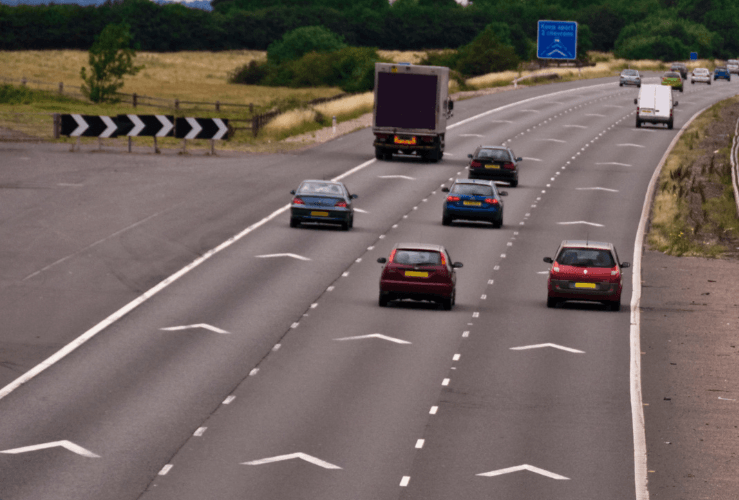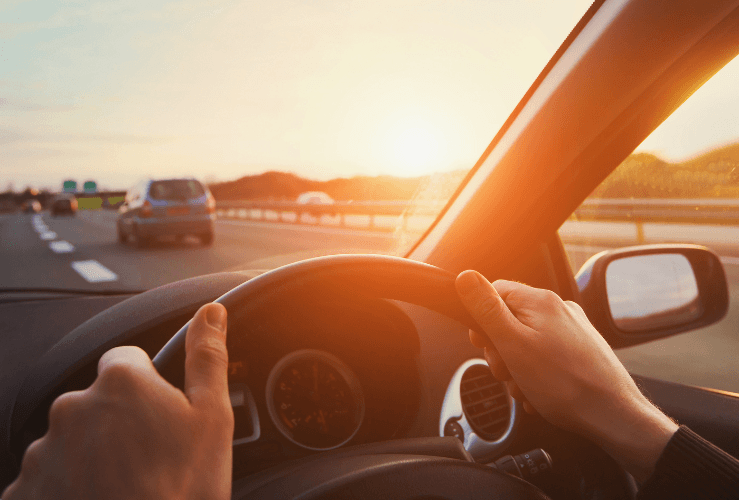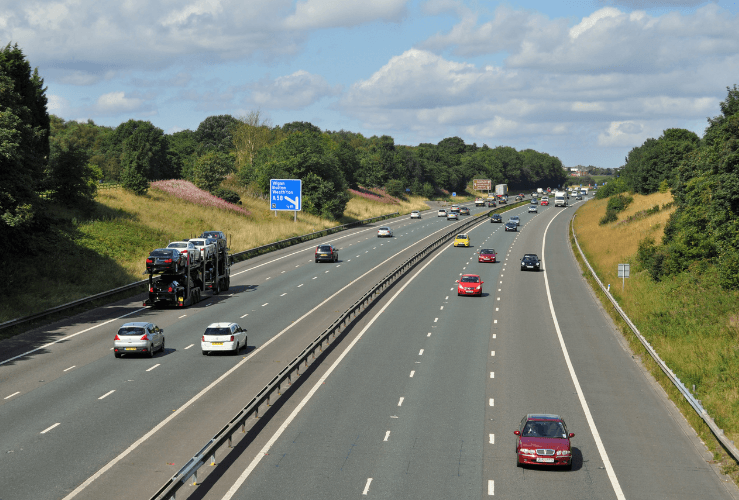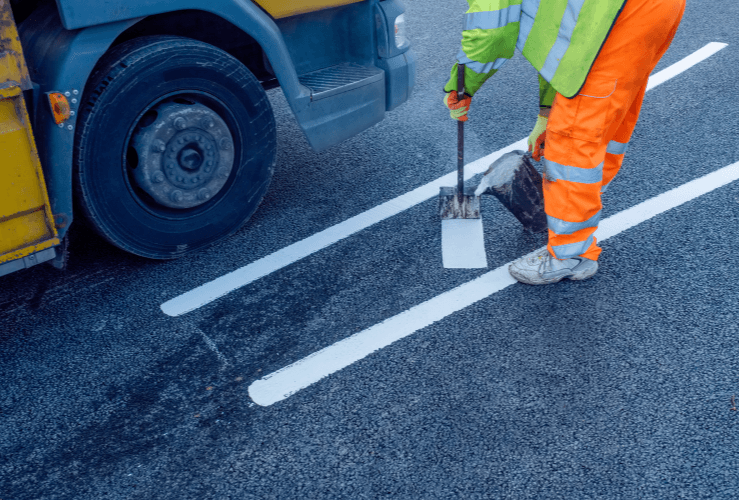Before driving on a motorway for the first time, make sure you understand how to enter, overtake and exit safely – and how to make driving pleasant for everyone by observing good motorway etiquette.

Driving on a motorway can be a daunting experience for new drivers.
If possible, bring along a more experienced driver the first time you drive on a motorway; Your driving instructor may have given you some motorway driving experience, but joining a motorway by yourself can be a stressful undertaking.
Before you start your journey:
- Plan your route
- Check the distance of your destination
- Plan where to stop for a break - if going on a longer journey
- Work out which junctions you'll be using
- Even if you have a satnav, take a backup smartphone or atlas
- Check your vehicle's tyre pressure and fluid levels - since breaking down on a motorway can be inconvenient and unpleasant.
Joining the motorway
When entering a motorway on a slip road, keep to the left lane. Build up speed and merge with the motorway traffic.
Other drivers may speed up or slow down to let you onto the motorway - but this is up to the driver’s discretion.
Check over your right shoulder to check for traffic that is not yet visible in your mirror.
Signal right, then choose a gap so you can merge into traffic smoothly.
Changing lane on a motorway
There could be two, three or four lanes on the motorway. Try not to think of the lanes as slow or fast, but instead keep to the left lane for normal driving. The other lanes are only for overtaking.
Always return to the left lane once the overtaking manoeuvre is complete.
Lane hogging
By staying in other lanes you will be impeding other drivers - and quite possibly annoy them.
Drivers that stay in the middle lane, for example, are sometimes called 'middle lane hoggers'.
Since 2013 those 'hogging' the middle lane can be fined £100 and be handed three penalty points on their license.
Hogging the middle lane is considered bad motorway driving etiquette.
Keep back from traffic

Chevrons and the two-second rule
Since motorway traffic travels at high speed, you need to give yourself more space should you need to slow down suddenly.
Some motorways have chevrons spaced along the motorway, to remind motorists of the safe distance.
If no chevrons are visible, remember the two second rule: leave two seconds of travelling time between you and the vehicle in front.
This will give you enough time to react should the vehicle in front slow down.
You can work this out by noting an upcoming object such as a road bridge or sign, then start counting. If we reach that object before two seconds have elapsed, drop back and try again.
Aim to position your vehicle diagonally from vehicles in other lanes; this allows enough space for them to change lanes if they decide to do so - minimising the risk of a collision.
A collision at motorway speeds is to be avoided. Minimise the time you are passing overlapping traffic.

Mirror checks on the motorway
Even when riding on a quiet section of motorway, you should conduct regular mirror checks to see if there is any traffic behind you. This will help ensure you spot any erratic driving from other road users, and spot emergency vehicles in good time.
As with driving on A or B roads, you must check your mirrors before changing lane speed. And of course, use your indicator before changing lanes.
Speeding drivers
While the UK motorway speed limit is usually 70mph, in reality many drivers exceed this limit.
This is another reason why checking your mirrors regularly is critical - especially before changing lanes.
The motorway speed limit may be lower than 70 mph in some circumstances, such as when roadworks are taking place.
Keep a lookout for road signs or overhead gantries displaying reduced/variable speed limits.
Variable speed limits help regulate traffic flow at busier times of the day.
Note that UK motorways now have many speed cameras, so regularly exceeding the speed limit could become costly. As gov.uk states, "The minimum penalty for speeding is a £100 fine and 3 penalty points added to your license."

Overtaking on the motorway
Due to the high speeds of motorway traffic, overtaking safely is of the utmost importance. Always adhere to the 'mirror, signal, manoeuvre' mantra before overtaking.
As you approach a slow vehicle that you wish to overtake, note the positions of vehicles around you. Having spotted a suitable gap, signal so other road users understand your intentions.
Move into the new lane, accelerate past the slower vehicle, then use your mirror and indicator to move back into the left lane.
During busier times, it may not be possible to switch back into the left lane when desired. Patience and alertness is required.
Take regular breaks
Studies reveal that around 20% of accidents have driver tiredness as a contributing factor.
You're more likely to have an accident if you're tired, so take a 15-minute break every two hours when undertaking long trips.
If you start to feel tired or drowsy, open a window until you reach the next motorway service station or rest area.
Remember that stopping on the hard shoulder is illegal unless it’s an emergency.
What to do if your car suffers a mechanical problem on the motorway?
If your vehicle develops a mechanical problem - or there is some other emergency - you may need to stop on the hard shoulder.
Never stop in a motorway lane, as this could be extremely dangerous with a high risk of collision.
Having stopped on the hard shoulder, turn on your hazard lights and exit the car to the left.
Stay on the verge until assistance arrives - since your stationery car could be hit by other vehicles.
Exiting the motorway safely
When the time comes to leave the motorway, take note of signs indicating that your desired junction is ahead.
Complete any overtaking then move into the left lane.
As the junction approaches, you'll see a blue sign with three white lines - indicating 300 yards (274m) until the exit. Similar signs will appear at 200 and 100 yards.
Signal if required then move into the slip road without slowing down too early. Slowing down too early could impede the traffic behind you. Brake smoothly in anticipation of a junction or bend in the road.
Speed perception after leaving a motorway
After travelling on the motorway, our perception of speed changes - so keep an eye on your speedometer as you approach the junction and join slower traffic.

Good motorway etiquette: 5 tips
Respect lane closure signs
Overhead gantries may sometimes display a red cross - this means you should not use that lane.
It may be closed due to an accident or breakdown. Using a closed lane could be dangerous since you don't know what obstacles are ahead.
Don't be tempted to skip ahead of traffic by temporarily using a closed lane. This is regarded bad motorway etiquette.
Keep the motorway hard shoulder clear
Don't be tempted to skip traffic by using the motorway hard shoulder. Aside from being bad etiquette, it could land you with a penalty from the police.
Don’t middle-lane hog
Occupying the middle lane increases congestion and could affect other road users. It is regarded as very poor motorway lane etiquette.
Keep to the motorway speed limit
This is especially important around road works, since people are working near the road.
Don’t tailgate
Driving too close to the vehicle ahead is dangerous and will also annoy the driver.
You need to leave enough space ahead so you can slow down safely if the vehicle ahead brakes suddenly.




